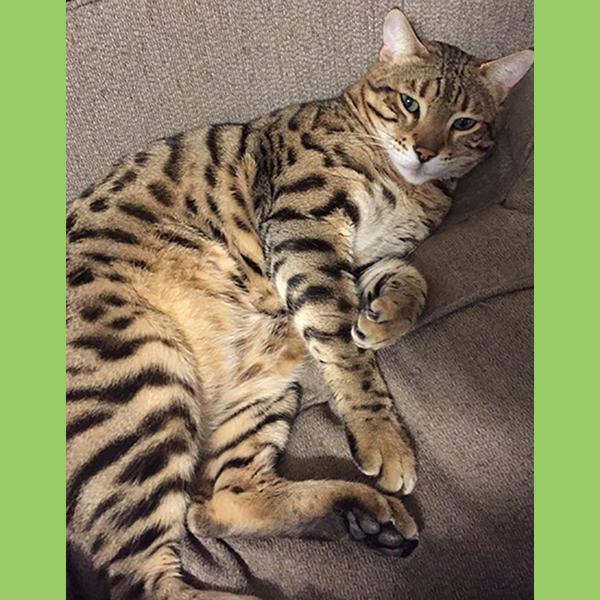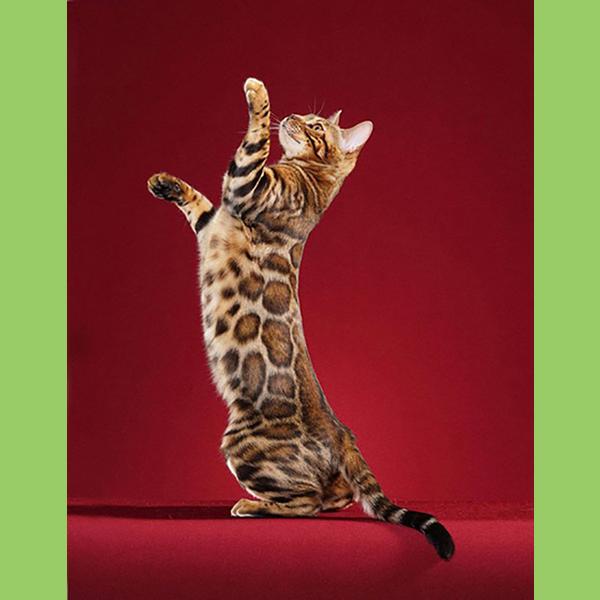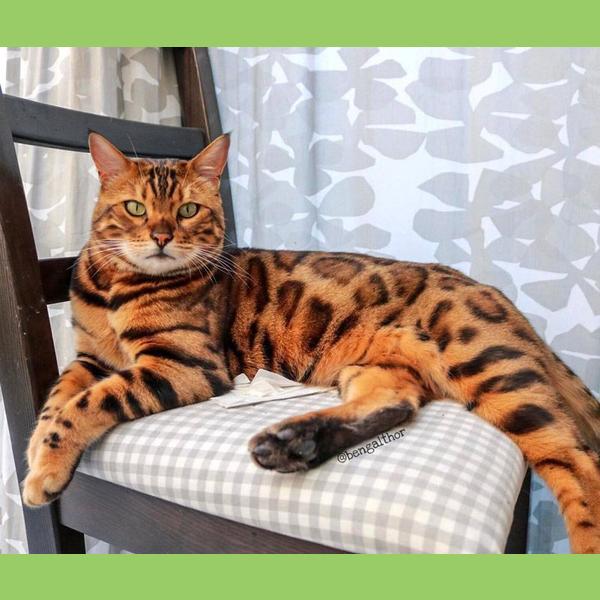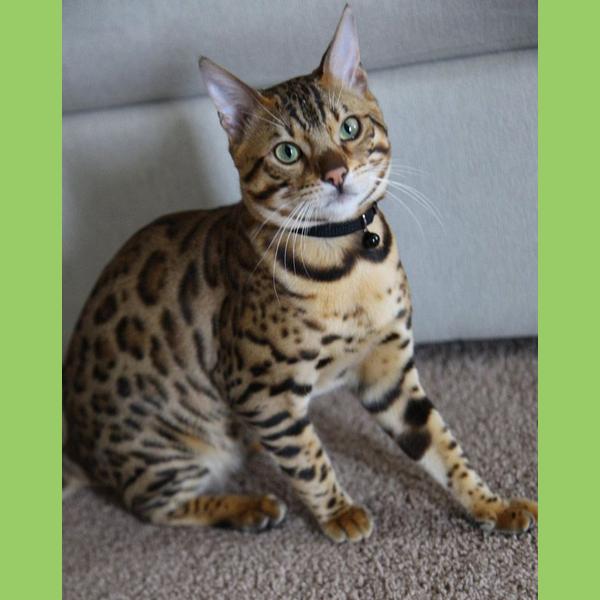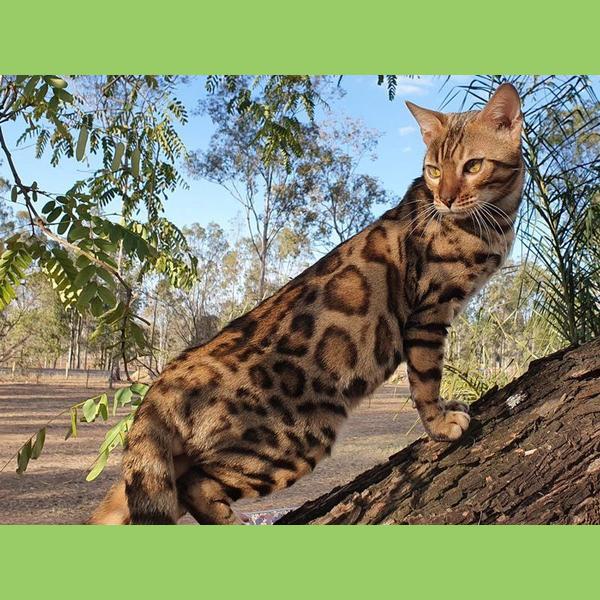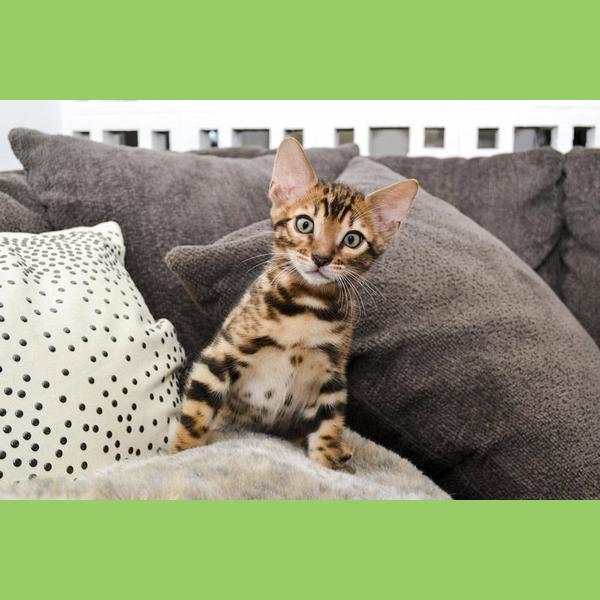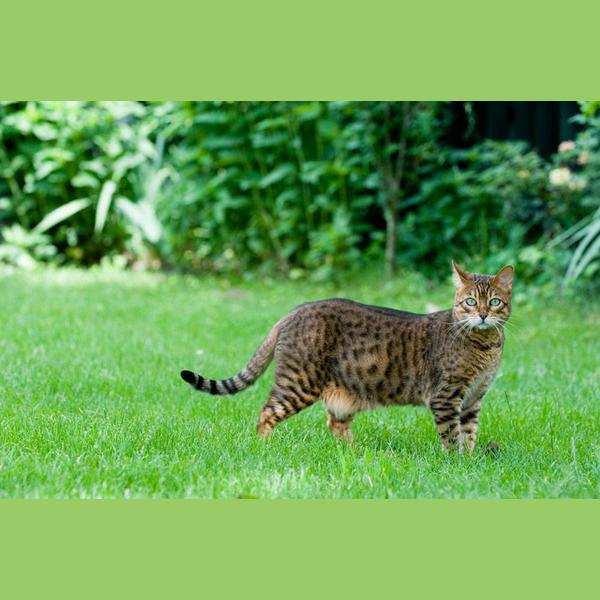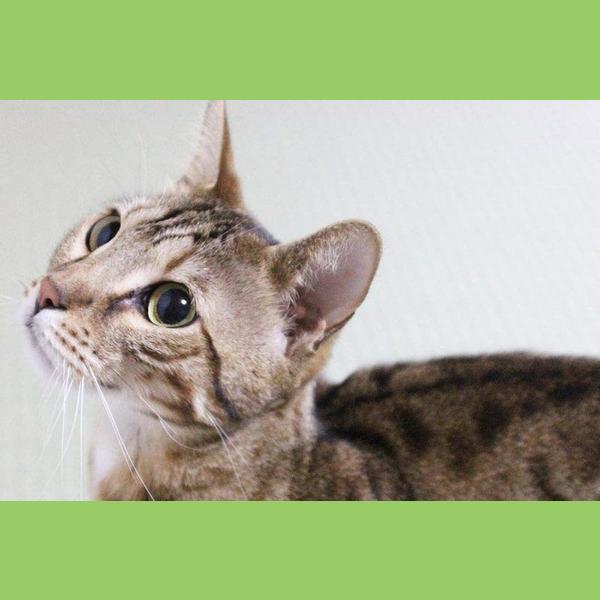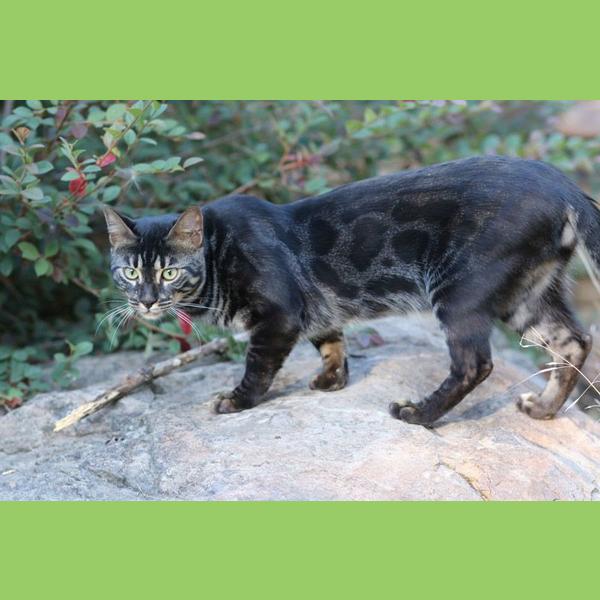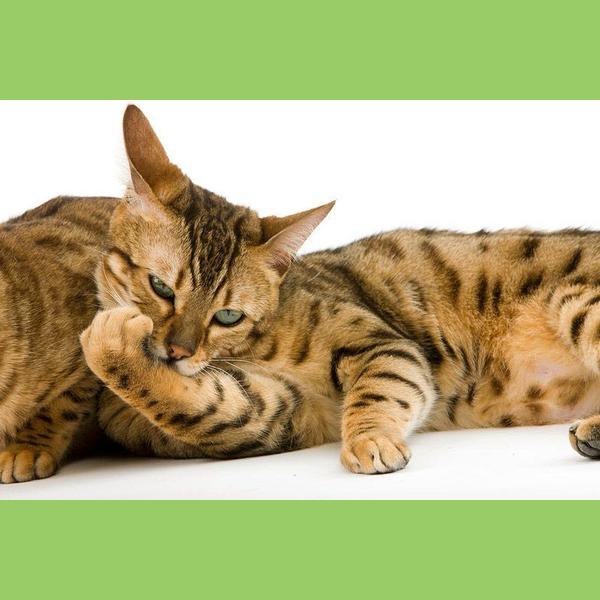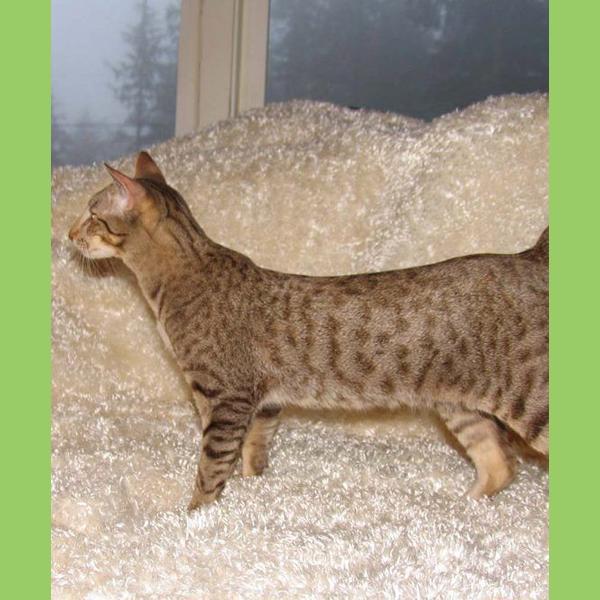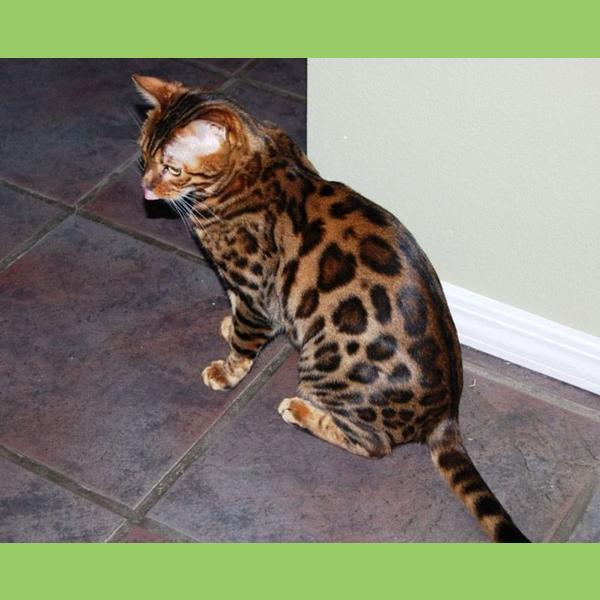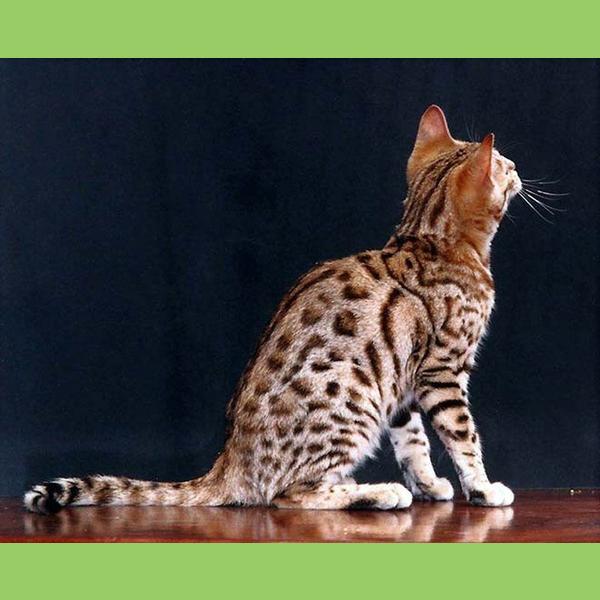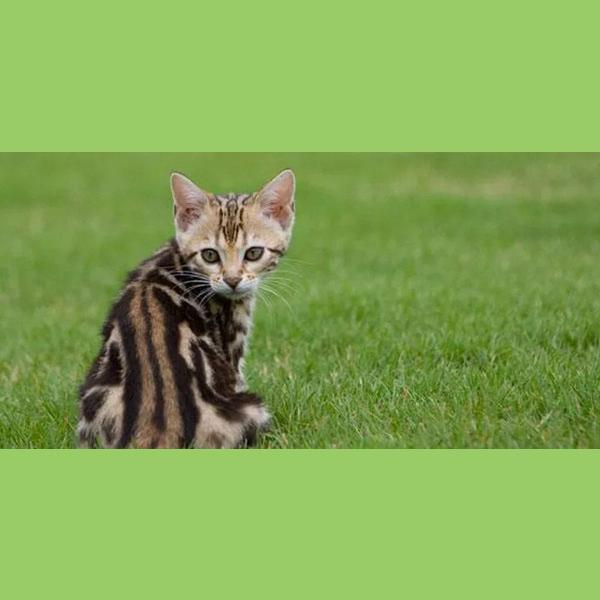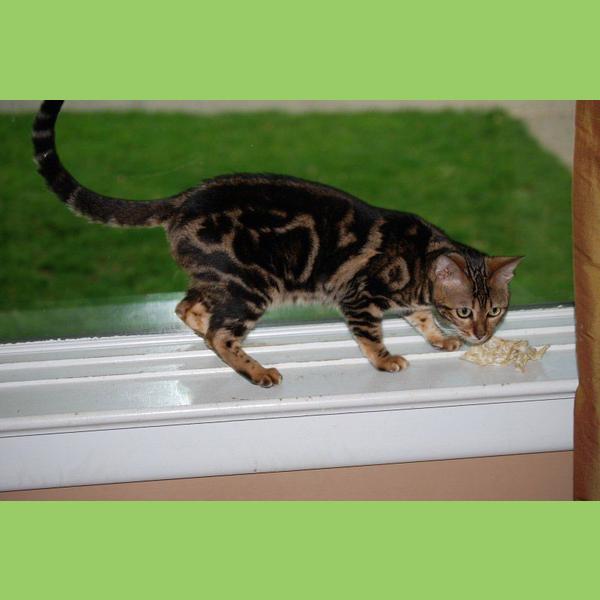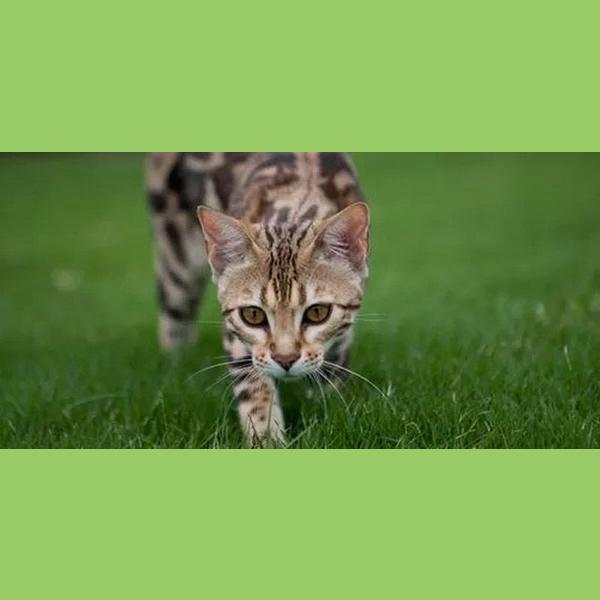Colors of Bengal cats (photos, names and descriptions)
Bengal cats are a dream come true. They are not only beautiful, they are pets with the appearance of a bright animal from the wild.
The color of Bengal cats is not only a "rosette on gold", so beloved by most ordinary people, there are many colors of these unique animals and they are all beautiful in their own way.

Breed history and genetics
In order to understand the nature of the Bengal cats variety of colors, it is necessary to delve a little into the history of the origin of this breed.

The fact is that this is the first hybrid variety of pets obtained by crossing domestic and wild cats, in this case originally the Egyptian Mau and the Asian Leopard Cat (ALC), which is also called the Small Asian Leopard, despite its very small size.
The first hybrid females of the future Bengal cats were Millwood Praline, Millwood Pennybank and Millwood Rorshack, from which, in fact, all 250 thousand animals of this breed registered in the world today originated.
All of them were derived by Willard Centerwall at his university laboratory Loma Linda. Dr. Centerwall created and left the world a huge legacy of diverse research and discoveries. Bengal cats are rightfully mentioned in the outstanding biography of this man.
This story began in 1980 and was started by the American Jean Mill. At that time, she did not have ALC, but it was not the first time she turned to the idea of creating a domestic cat that would look like a Leopard. She first crossed a domestic cat with an Asian Leopard Cat (Prionailurus bengalensis) in 1963.
The adoption of the Endangered Species Act in 1973 and the inclusion of the Asian Leopard Cat in the attached list of endangered Species of the United States and Wildlife dated June 14, 1976 put an end to the unregulated importation of ALCS and other wild animals into the United States.
The public attitude towards wildlife was changing, which made the desire to live with a domestic "leopard" more and more acute and popular, with an increasing recognition that such a situation is not ideal for wild animals and, probably, for neighbors.
Dr. Willard Centerwall was known to Jean Mill and others who were interested in the hybridization of domestic and Asian Leopard Cats thanks to an article he wrote that was originally published in the December 1974 issue of Cats Magazine, The Truth about Hybrids. A copy of it was given to Jean Mill in November 1981. In this article, Dr. Centerwall explains in detail the purpose of the research for which the cat hybrid breeding program was launched, and the nature of the animals themselves.
The scientist has already tried to explain to the public the difference between reality and bizarre fairy tales sold in the secret section of this very magazine. The medical, veterinary and academic communities were familiar with Dr. Centerwall on the basis of the significant contribution he had made to science to this point.
At the time of publication of the articles, he was professor of pediatrics at the Medical School, professor of Maternal and Child Health at the School of Health, lecturer in anthropology at Loma Linda University for more than ten years, as well as head of the Department of Genetics, Birth Defects and Chromosomal Relationships. There are dozens of peer-reviewed journal articles, the authors or researchers of which are Centerwall and his wife Seigfried.
In 1960, Dr. Centerwall published one of the first tests to detect hereditary diseases in children, a condition known as phenylketonuria, in the course of his research he gave a chromosomal analysis of the Rusty Spotted tomcat (Prionailurus rubiginosa) in 1983 and the Sumatran or Flathead Cat (Prionailurus planiceps) in 1977. By the time the "Truth about Hybrids" was published, the first generations of hybrid animals from ALC were not uncommon.
After the successful start of hybrid breeding of Jean Mill in 1963 and her publication of photographs and articles for other enthusiasts through the newsletter of the Ocelot Club on Long Island (later renamed the Leopard Cat Information Center) Cornell Universities have reported a lot about this experience.
These cats were mostly novelties, not intended to participate in a broader program, but rather exclusive animals.
By 1970, so many hybrids had been bred that one woman devoted to Asian Leopard Cats as a species, Virginia English, implored other exotic feline enthusiasts to resist their creation in a letter to the editor of the Long Island Ocelot Club newsletter.
Ms. English asked for the opportunity to register Asian Leopard Cats with the CFA Cat Lovers Association in order to enter them into the registry in the USA.
Dr. Centerwall started his program in 1971. In April 1973, the Los Angeles Times published an article about his interesting project and sent a film crew to shoot and interview the scientist. This two–minute video is the best of the remaining images of Asian Leopard Cats, pets and F1 hybrids that have contributed to the modern breed of Bengal cats.
Throughout 1973, photos and some versions of the article appeared in newspapers throughout the United States. It talked about the possibilities of the program, and also featured a charming photo of a domestic F1 Asian Leopard Cat kitten with the likely mother of the kitten.
By the end of the 1970s, for various reasons, Dr. Centerwall's project in the field of cats ended.
Using some of his research, an article was published in the journal Science in 1975 demonstrating that a domestic cat and its close relatives possessed the gene sequences necessary for the replication of the gamma retrovirus of feline leukemia, but were absent in more distantly related species, for example, such as the Asian Leopard Cat.
It was at this time that Dr. Centerwall himself kept a very select group of cats for vital measurements of animal indicators, while other animals were placed with knowledgeable owners.
Luck intervened when Jean Mill met this scientist. She placed ads in the Los Angeles Times and Cats Magazine, where she searched for existing ALA hybrids from breeding programs.
At that time, Dr. Centerwall was trying to help find content for hybrid cats belonging to a person who had enough of them. This man was Gordon Meredith, a highly regarded Hollywood trainer who provided shelter for some cats when the original owners got tired of their difficult nature and difficult habits.
Dr. Centerwall and Gordon Meredith provided Jean with half a dozen first-generation female cats between the ages of six and eight. The animals ranged in color from various shades of brown spotted tabby to brown marble.
Among the females was an eight-year-old hybrid cat named Favi, short for "Favorite". This is one of the most beautiful animals ever created in Dr. Centerwall's program. Jean registered Favi as Millwood Pennybank.
Millwood Penny bank was a free gift presented to Jean from Dr. Centerwall's in the hope that their project would be successful.
It should be pointed out here that the earliest mention of the crossing of ALCS and domestic cats was back in 1889, when Harrison Weir wrote about them in the article "Our cats and everything about them". The next mention of unusual breeding was published in a Belgian scientific journal in 1924, and in 1941 an article was published in a Japanese publication about cats that such a hybrid lived in the house as a pet.
Reproduction always stopped after one or two generations.
Only Jean Mill was the breeder who decides to bread and register a new breed based on hybrids.
It was not an easy path that went through many difficult stages:
- In 1983, the breed was officially adopted by the International Cat Association (TICA). Bengal cat received the status of champion in 1991.
- In 1997, the Board of Governors of Cat Fancy (GCCF) also adopted Bengal cats as a new breed.
- In 1999, the Fédération Internationale Feline (FIFe) registered Bengal cats in its registry.
- The Cat Lovers Association (CFA) was one of the last official feline organization to approve a hybrid breed. At the same time, the CFA Board finally accepted the bengal cats only at a meeting on February 7, 2016. According to their charter, in order for an animal to be registered with the CFA, it must be F6 or later generation.
- In 1999, the Australian Cat Federation (WCF) also included the Bengal Cat in its registry.
Bengal cats from the first three breeding tribes (F1-F3) are considered "basic cats" or "early generations". These males (F1-F3) are usually infertile. Therefore, it is the females F1, F2 and F3 that are responsible for obtaining fertile domestic Bengals. The female F1 hybrid is quite fertile, so she is used in subsequent, unidirectional mating with fertile domestic males.
Some males produced viable sperm already in the F2 generation, but this is considered rare in breeding communities that regularly return females of the earlier generation to the later generation of fertile hybrid males.
To be considered a domestic Bengal cat according to the main register of felinological organizations, the animal must be at least in the fourth generation (F4) or more from ALCOHOL.
The bright hybrid variety was most fully developed by the 1980s. In 1992, 125 breeders were registered in the International Cat Association. By the 2000s, Bengal cats had become a very popular breed. In 2019, there are more than 1,000 breeders in the world engaged in breeding these animals, although, most likely, there are much more of them, since only nurseries bearing the word "Bengal" in their name were taken into account in the statistics.
Bengal cats are usually medium to large in size. On average, their weight: males 5-8 kg, females 4-5 kg, although there are larger individuals (up to 14 kg). These are slender and athletically built animals with excellent musculature, due to which they are perceived to be larger and have a more predatory wild appearance
In some states of America, legal restrictions have been imposed on this breed. So, in New York and Hawaii, Bengal cats are prohibited by law (like all other hybrids of domestic and wild cat species). In various other places, such as Seattle, Washington, and Denver, Colorado, there are certain restrictions on the ownership of these animals.
Bengals of the F1-F4 generations are also regulated in the states of New York, Georgia, Massachusetts, Delaware, Connecticut and Indiana, and are completely banned in Australia. In general, in the United States of America, with the exception of the cases mentioned above, Bengal cats with generation F5 and above are considered domestic and, as a rule, are legal.
At one time, Bengal cats were regulated in the UK. Nevertheless, the Department of Environment, Food and Agriculture abolished the previous licensing requirements in 2007.
Bengal cats are smart, energetic and playful. Many of their owners say that these pets are able to naturally get any object that interests them and they often like to frolic in the water.
The International Cat Association (TICA) describes the Bengal cat as active and inquisitive, which loves energetic movements and height. Most of the colorful animals like to play, chase, climb and explore.
Bengal cats tend to be confident, curious and loyal companions. They get along well with other pets when they are properly introduced and they enjoy being part of the family.
Standards colors of Bengal cats
Any pets, regardless of pedigree and variety, can have different colors and patterns. The popular spotted and golden leopard skin is not the only color and pattern accepted by felinologists for this breed.
Bengal cats are some versions of their big relatives from the jungle. Therefore, this breed has a very wide range of color morphs, shades and patterns.
The genetic origin of both parents in a breeding pair has a strong influence on the result of crossing, Bengals even of the same litter can differ significantly from each other. Fortunately, mapping the feline genome has allowed the genes that control the coat, colour and pattern in cats to be studied and identified using DNA tests
Genetic testing enables felinologists to predict the possible results of upcoming litters and can prevent possible diseases at that stage so that they do not become an integral part of the breed.
Strictly speaking, there are only three generally accepted color isomorphs acceptable to Bengal cats:
- brown or gold (brown);
- silver;
- three types of snow (Seal Lynx, Seal Sepia and Seal Mink Point).
Within each color type there are two accepted categories of the standard – spotted (spotted tabby) and marble (marble).
With so many variations of colors of Bengal cats, it is not so easy to choose the of your dreams.
There are only nine Bengal cats colors recognized to date. They are given here with the spelling in the English version and the generally accepted marking in felinological documents
- Brown (Black) marbled (Brown (Black) marbled) BEN 22.
- Seal Sepia / Seal Pink marble (Seal sepia/Seal mink marbled) BEN n 22 31/32.
- Snow marbled/spotted and seal lynx point (Snow marbled/spotted and seal lynx point) BEN n 22/24 33.
- Brown (Black) spotted (Brown (Black) spotted) BEN n 24.
- Seal Sepia / Seal Mink spotted (Seal sepia/Seal mink spotted) BEN n 24 31/32.
- Brown (Black) marble silver (Brown (Black) silver marble) BENns 22.
- Seal Special / Seal Mink marble silver (Seal sepia/Seal mink silver marble) BE ns22 31/32.
- Snow marbled/spotted silver and seal lynx point (Snow marbled/spotted point) and seal lynx point) BEN ns 22/24 33.
- Brown (black) spotted silver (Brown (Black) silver spotted) BEN ns 24.
- Seal Special / Seal Mink spotted silver (Seal sepia/Seal mink silver spotted) BEN ns 24 31/32.
Although there are already many new colors that have not yet been recognized or are experimental. According to some reports, blue colors have been registered in TICA.
With the help of the Bengal cats color guide, you can determine exactly what the future owner is looking for.
Spotted and Rosette (Spotted Tabby or Spotted Rosetted)
Spotted colors of Bengal cats today remain the most popular in the styles of colors.
It was the brown spotted tabby cat that was recognized as a Champion (TICA) in 1991.
Tabby Bengalis distinguished by characteristic spots of small to medium size throughout the coat. Large, random, two-color rosette markings are especially appreciated, since in this case the pet resembles a miniature Leopard. Such a reference style emerged at a time when breeders considered larger and rare markings the most desirable.
The original spotted striped colors presented in pets participating in breeding have been changed through long selection.
The animal's fur coat is covered with random diagonally or horizontally placed markers on the body, abdomen and limbs. Large dark markings on a lightened main background are considered preferable.
In the spotted type itself, different types of species are possible on one animal. Even in the brown spotted or rosette type, bengal cats can be: red, brown, black, ticked, gray, spotted, rosets, cloudy.
Many people are stunned by the resemblance of a Bengal cat to a leopard. Among Bengal domestic cats, markings are perhaps the most diverse and unique.
Single-Spotted
This color means that the markings are monochrome. It is a carpet of solid spots sprinkled with drops on a lighter background, similar to markers of wild cats, such as Cheetahs or non-hybrid spotted animals of different breeds (Ociket, Egyptian Mau, Spotted Shorthair or Australian Mist).

Bengal cats with monochrome spots take part in competitions and cat shows, but they are no longer unique in today's realities. A small number of breeders even express the opinion that they should not participate in contests. Fortunately, not all felinologists adhere to this point of view, because this wild color is very beautiful.
Rosetted Bengal
Of the numerous spotted Bengal cats colors among modern breeders, "Rosetted Bengal cats" is the most popular today.

Solid markings turn into rosettes when they are two-tone contrasting prints, very different from the background shade. Bengal cats are the only ones among domestic brands that have the label "rosette".
This print in Bengal cats communities began to appear and develop rapidly only in the early 2000s, when some breeders managed to get shaded spots on the background color.
When observing the evolution of the breed over the years, the achievements that the most outstanding breeders managed to get when working with the "outlet" in just a couple of decades are especially vividly and surprisingly traced.
There are three main categories of sockets:
- Arrowhead (arrowhead);
- Jaguar paw print (paw-print);
- Donut (donut).

Some of their modifications are also known.

At the same time, according to the standard of the Bengal breed, the spots or rosettes in the drawing should have been aligned horizontally, and not vertically, as in the classic tabby.
Socket type "Arrows" (arrow-head)
Arrow-shaped spots on the Bengal cats fur coat give them a particularly smooth horizontal appearance and create a unique illusory movement.
Arrows can be solid and monochrome within the same group of spots, or they can form rosettes with different colors disappearing into the background. Well-defined arrowhead rings are rare and highly prized by breeders and Bengal owners.

Sockets of the "arrow" type are not the most common, but at the same time they are the easiest to recognize.
The sockets of the "arrowhead" have triangular shapes similar to drops, and they all face the animal's back.
The Asian Leopard Cat has many different shapes and colors, but the arrow markings are one of the brightest. Such prints allow the animal to camouflage perfectly in the mottled light of the forest habitat, and an animal of this color is very difficult to detect when it is on trees or among fallen leaves.
 Asian cat
Asian cat
Bagel or Donut-socket (donut)
Ring rosettes are markings that are darker than the background color of the Bengal cat wool cover and at the same time are highlighted with an even more saturated contour.
They are so called due to a completely or almost completely closed dark ring, in which the center is painted in shades lighter by at least two or three tones.

It took many years of selective breeding for experienced specialists to generate a ring-shaped outlet, but now these prints have been at the peak of popularity for the second decade and are in high demand among owners. Some also distinguish this type of markings depending on the size of their contour and overall dimensions. The so-called "pancake" is described as huge rosettes with thin outlines.
Ring markers have a thicker outline than "pancakes".
Jaguar paw print (Pawprint)
"Rosette with paw print" – shaded markers, partially unclosed in at least one place, with smaller and contrasting spots on the edges.
Their peculiarity is that the Pawprint is never framed by a thicker and contrasting ambient shade.

Resembling the coloring of a real Leopard, the Pawprint rosette has rightfully earned its name, since they really resemble miniature jaguar prints stretching all over the wool cover of Bengal cats.

Smoky rosette (Clouded Rosettes)
Smoke rings are large hollow markings that look like a puzzle with a small interval between the details.

This reticulated spot resembling the coat of a clouded leopard, somewhat similar to snake skin.
Chain socket (Chain Rosetting)
It describes a series of "doughnut" or "bublic" rings connected horizontally and running along the spine of the animal and parallel to it on both sides.

The color "chain socket" looks the most advantageous and is especially characteristic of such a bright wild cat as an Ocelot.
Cluster socket (Cluster Rosettes)
It is a conglomerate of small spots forming clusters around a lighter color.

Thus, if a person is looking for a future pet, for example, an image of a Jaguar, Leopard or Ocelot, he needs a color with a socket.
Marble (Marbled)
Domestic cats have four distinct and inherited coat patterns – ticked, mackerel, multicolored (with spots of other colors) and spotted, all together referred to as tabby markings.

The Bengal cat has a marble pattern derived from spotted tabby. This pattern is full of swirls, showing clear markings with sharp edges. A spiral or round ("bullseye") marker is undesirable. A random pattern and additional color tones inside the pattern are preferred. The animal needs to have patterned markings on the shoulders and multicolored markers on the legs and tail. The belly should be spotted.
Christopher Kelin, a geneticist from the university, conducted a study that was used to identify the tabby and marble alleles in a domestic Bengal cat. Kelin studied the coloration and pattern variations of a wildcat in Northern California and was able to identify the gene responsible for the Bengali pattern "marble".
The marble wool pattern is derived from tabby striped prints that curl, twist. The ideal marble Bengal should have horizontally arranged, but at the same time smoothed asymmetric patterned flows smoothly enough into each other, consisting of a swirl of two or more shades. Thus, there are the following four recognized categories of Bengal Marble: short swirls in the horizontal plane, the same, but longer, chaotic pattern and patterned sheet marble (cloak).
In 1987, Jean Mill in her Millwood nursery produced the first marble Bengal cat from a cat named Millwood Painted Desert.
The marble cub was a spectacular small female with an amazing soft creamy coloring and an unusual print resembling hot caramel splashes. At the Madison Square Garden competition and across America, she made a sensation.
The first standard for the Bengal breed from Jean Mill did not provide for anything in the coat pattern except monochrome spots. Painted Desert (the name of the first marble bengalka translates as Painted Desert) was instantly recognized by experts and all the people present at the show, the marbles were later included in the new Bengal standards.
The descendants of these early marble Bengal cats provided the genetic material for obtaining the first rosettes in the 2000s, it was their alleles that helped form a new type of pattern.

In 1993, Marble Bengal cat received the status of champion within TICA.
Sparble (Sparbled)
The beauty of the marble color does not end there. An amazing bonus can be called the fact that in the coloring of a newborn Bengal cat, the breeder discovers a combination of marble and spotted drawings.

"Sparbled" is not currently allocated to a separate registered category of patterns, but in the breeders' jargon it is used as a characteristic of animals with ring sockets and marble prints, or tabby cats with marble markers.
Sparble are considered by color to belong to the category of spotted or rosette tabby, not marble.

Color isomorphs of bengal cats
Bengal cats can be silver, brown, black (mechanistic), snowy, red, cinnamon, smoke, charcoal, blue.
Bengal cats may have spotted markings, rosette or marble patterns on their fur. The fur of the animals is very soft and short.
At the same time, the International Cat Association (TICA) recognizes only a few Bengali colors (brown, red seal, mink, sepia, silver) and drawings (spotted and marbled) for competitions and exhibitions.
In the "New Features" category, other colors can be shown, as well as long-haired Bengals, which are also called cashmere.
As in other cat breeds, Bengals have different color morphs. The International Cat Association (TICA) recognizes six shades of the breed, which it divides into recognized and unrecognized.
Standard Bengali colors include:
- brown or black brown;
- snow color in various variations;
- silver varieties.
Unrecognized or unapproved non - standard shades of Bengal cats are as follows:
- charcoal or charcoal;
- blue;
- melanistic (solid coal).
Brown colors
Golden Bengal cats are still recognized as the most popular of all approved colors, they were the first in the breed adopted by TICA in 1983.

Traditional Bengal cats brown (more often they are called Gold) have irises of emerald or golden shades.

The background tones of the wool cover can vary from brownish-grayish shades to bright golden-orange.
The color of specks, rosette or marble prints varies from charcoal, light brownish to brownish-red.
Sam brown comes in different color shades, namely: golden, cream, yellowish-brown, honey, gray-brownish, beige, dark cream, caramel, cinnamon. Any of these tones are accepted, but golden-orange is preferred as the main shade.
 Brown and Silver colors
Brown and Silver colors
Brown Bengal is characterized by the following signs:
- markings from brownish to thick charcoal tones;
- black marker on the tip of the tail;
- brick-reddish nose lobe;
- copper, gold, green or brown-tinged cornea of the eyes;
- preference is given to a light, and preferably a white abdomen.
Snow Bengal Cat
Such an animal can be safely called a snow leopard in miniature.
Bengals can have cream shades in their color range, as well as ivory colors associated with a form of albinism that comes from Siamese and Burmese cats.

Contrary to what follows from the name, the animals do not look absolutely snow-white.
Snow Bengal cats exists in three different shades, which are directly related to the genetic characteristics of animals and the gene set of alleles:
- Lynx (Seal Lynx);

- Mink (Seal Mink);

- Sepia (Seal Sepia).

Most often, it is very difficult to catch the difference in the colors of snow wool purely externally, and then a genetic test serves as the preferred means to determine the truth. Although the shade of the cornea of the eyes can significantly facilitate identification, even in this case, the best judges and specialists sometimes make mistakes.
The Snow Links can be identified most easily by the following signs:
- A very light, almost white or cream-colored background tone.
- Dark or light gray markings.
- Shaded brownish tip of the tail.
- Always only the blue cornea of the eyes.

Snow Minks are much more difficult to identify and are often confused with Sepia. But nevertheless they have the following characteristics:
- The main background of the main shades: ivory, light creamy, pale beige.
- A variety of colors of prints from the colors "mink" or "seal" to almost black.
- Grayish or brownish tip of the tail.
- Blue-emerald or aquamarine eyes.

The sepia differs in the following parameters:
- The background is ivory, creamy, pale brownish.
- A variety of colors of prints from light to dark sepia.
- The tail ends in a dark gray or thick brown color.
- The cornea of the eyes is green or gold.

Silver Bengal Cats
Silver in felinology is rather the disadvantages of colors. These genes suppress any warm tone and produce a snow-like base layer that comes into contrast with bright dark markers.
Silver color was introduced into the standard and the TICA championship only in 2004 and only for this variety of cats.

The silver Bengal cat can be of different shades with a basic background from white to very dark steel colors.
Bengali "silver" is also found in any other color combinations: Silver Snow, Silver Charcoal, Blue Silver and others.

Silver Bengal cats are characterized by the following distinctive features:
- They should not have dull shades in color (yellow, rusty, brown), this is considered a serious drawback and is called "rufism".
- Prints from dark gray to thick black shades.
- The tip of the tail must be carbon.
- Brick-red nose lobe.
- The cornea of the eyes is bright golden or emerald.

Charcoal
Bengal charcoal is darker than the traditional colors recognized in this breed.

Black smoky charcoal color was most common in the early hybrid generations of F1 and F2.
Charcoal features are inherited regardless of the colors and can be traced in any color categories: brown (gold), silver, snow or blue.

Charcoal is distinguished by a dark grayish, brownish or charcoal background shade with a small amount or almost no red (reddish-brown) and at least a tone darker with spotted or marble prints.
Charcoal often has a characteristic "mask" on the muzzle, it is much more contrasting and thicker than the main background, and a wide dorsal stripe, often referred to as the "cape and mask of Zorro", since the "mask" looks like an inverted letter "Y" or a peace sign without a circle around it.
The mask most often corresponds to the color of black spots on the body.

The tails of charcoals are dark brown, black or grayish-black with stripes and charcoal tips.
Dark chocolate and silver-tinged coals have a black body with "ghostly" markings. Therefore, they are easily confused with solid melanists, but the latter cannot have a mask on their muzzle.

Blue Bengal cats
The blue tones of the Bengals' fur are extremely rare, but individual breeders are now expending huge efforts in order to promote such pets to the status of champions.

The Blue Bengal is distinguished by a bluish-grayish coat, as if sprinkled with powder, with some creamy shades. Tabby or marble drawings are always darker, deep blue or metallic gray tones. Since the "blue" gene is recessive, it is both producers, male and female, who must be its carriers in order for the offspring to turn out to be "blue" as well.

Blue Bengal cat is distinguished by the following features:
- Steel or blue main background.
- Peach shades of prints.
- Blue markings have no right to be black.
- The tip of the tail is only dark gray.
- The iris of the eyes is golden, green or brown.

Bengal-Melanistic
Solid Bengals-coals are distinguished by black patterns on the black main background, they are very similar in color to the melanistic color variant of the Leopard and Jaguar, namely, the black panther.

The Asian leopard melanistic Cat is also found in nature, so this color is understandable.

The background color and pattern of Bengal are melanistic of the same shade. Prints in this case are called "ghost marks" or "ghost markers", since they are barely distinguishable. But in good daylight, especially with a high gloss of wool, they are clearly visible.
Coal melanists are rare and not very popular among breeders, because this color change has not yet been approved by felinological associations. Although, most likely, this is temporary, because these animals are insanely beautiful. And, as many breeders note, they have a more docile character, like black cats of any breed.

Prints are most often made in shades from faint dark brown to black and are usually visible only in natural sunlight.
Bengal smoke is a silver variety of melanistic.

Glitter Bengal cats
Bengal is the first pet that has an unusual sheen of wool, called glitter, but it is not found in all specimens of these animals.

The glitter shimmer of bengal wool occurs due to the translucent hollow shaft of the hair, the light is captured by it and reflected, causing mysterious shine, shimmer and iridescence.
Patina and ticking of bengal wool
The first sign is expressed in the black tips of each hair, due to which the pattern from the withers to the back of the animal is somewhat blurred.

Ticking also causes a slight blurring of the drawings, hiding the contrast. This is due to the fact that the multicolored hair rods give the fur a "faded" look.
New rare colors of the Bengal cat
In addition to not yet approved, but widely known colors, Bengals have completely new colors, almostunknown even to most breeders.
Cashmere Bengal cat
Some long-haired animals (more precisely, semi-long-haired) have always been encountered in Bengali breeding, since many different domestic cats were used during the formation of the breed, and theoretically it is believed that the gene for long hair originated from one of these reverse intersections.

A genetic test for long hair has been developed so that breeders can choose Bengal cats with a recessive gene for their cashmere breeding programs.

Some Bengal cats used in breeding may carry a recessive longhair gene.
When both parents carry a copy of the recessive long hair gene, and these two Bengals mate with each other, they can produce long-haired Bengals.

In the past, the long-haired descendants of Bengali mating were sterilized orcastrated, until some breeders decided to develop a long-haired branch, which they called cashmere.

Long-haired Bengal cats are not usually recognized in cat standards, however, since 2013 they have had a "preliminary" breed status in the New Zealand Feline Fantasy Registry (NZCF) under the name "Bengal cashmere".

Siamo-Himalayan type
This is very rare, but sometimes, especially in the late litters of snow Bengals, one or two kittens are born with a characteristic reflection of color-point coloring. At the same time, the main background has its own characteristic color – a spot, a rosette or marble.

More often, Siamese-Himalayan Bengals are in cream, darkening with age tones. Sometimes kittens with a blue or silver tint are also born, called "smokies".


